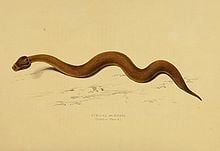Subphylum Vertebrata Suborder Serpentes Rank Species | Phylum Chordata Family Viperidae Higher classification Bitis | |
 | ||
Similar Bitis heraldica, Bitis, Snake, Bitis xeropaga, Bitis rubida | ||
Bitis inornata is a venomous viper species found only in Cape Province, South Africa. No subspecies are currently recognized.
Contents
Description
Adults average 25–40 cm (about 10-16 inches) in total length, with a maximum recorded total length of 45 cm (18 in).
Geographic range
An isolated population exists on the Sneeuberg, eastern Cape Province, South Africa.
The type locality is listed as "Sneeuwbergen, or Snow Mountains, ... immediately behind the village of Graaff Raynet" (Eastern Cape Province, South Africa).
Spawls and Branch (1995) described it as known only from two isolated populations in southern Cape Province in South Africa: the first in the east, limited to the montane grassland of the Sneeuberge, from north of Graaff-Reinet to Cradock. A second population was discovered relatively recently on the upper slopes of the Cederberg in the west.
Conservation status
This species is classified as vulnerable (VU) on the IUCN Red List for the following criteria: A2cd, B1+2ab. This means a population reduction of at least 20% is projected or suspected to be met within the next ten years or three generations, whichever is the longer, due to a decline in the area of occupancy, extent of occurrence and/or quality of habitat, or due to actual or potential levels of exploitation. Also, the extent of occurrence is estimated to cover less than 100 km², or the area of occupancy is estimated to be less than 10 km², and the population is severely fragmented or known to exist at only a single location. Finally, a continuing decline has been observed, inferred or projected, in the area of occupancy (year assessed: 1996).
